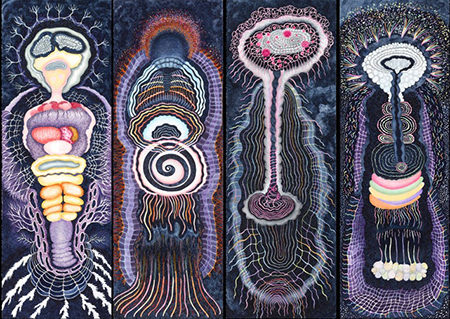
Continuing through January 6, 2019
Surrounded as it is by hospitals on Seattle’s First Hill (or “Pill Hill,” as it is known), it makes sense that the Frye Art Museum would finally devote an exhibition to various sorts of healing. However, it is also ironic that its founder, Charles Frye, made a fortune from the cultivation, transportation and sales of beef cattle, a cause of heart disease, and that much of the pseudoscientific gobbledygook surrounding “Group Therapy” emerges from outlandish and often repudiated 19th century ideas, Frye’s birth century. He died in 1940 and left his fortune to display and preserve his collection of 19th-century German and Northern European art. Contemporary curator Amanda Doonan’s brochure essay makes a valiant case for the validity of having such an exhibition, but goes too far in blaming “neoliberal capitalism” and the selfish museum-going audience as “self-optimizing” rather than promoting “measurable social benefit,” as do the 12 artists on view.
With the other artists hailing from New York City, Los Angeles, Copenhagen, and Berlin, one of only two local artists, Ann Leda Shapiro, was censored at her 1973 Whitney Museum of American Art solo debut for her omni-sexual symbolic portraits. Leda Shapiro is now hailed as an early feminist martyr. Hairy paper cutouts of wildly imagined female-male generative organs follow lines of Chinese energy flow. The images summon up a science-fiction world of ambisexual beings who literally re-conceive the universe. With Shapiro, the oldest of the group at 72, Doonan might have been better off devoting the entire exhibition to her.
The problem with the rest of the exhibition is that it is not visual enough to fully support the expansive curatorial claims. Invoking the increasingly repudiated twin giants of psychiatry, Sigmund Freud and Carl Jung as well as “Scream Therapy” founder Arthur Janov, in Liz Magic Laser’s “Primal Speech,” Doonan manages to rope in Breixit and the 2016 presidential election, too. Actors were paid to whine about offensive personal experiences in front of a camera which is then turned on museum-goers so they can complain, too. More pertinent and less dependent on headlines, Kandis Williams parodies Andy Warhol’s giant last “Rorschach Paintings” by replacing the squeegee brush with multiple images of the hands of famous civil-rights figures. In a subtle move she leaves the interpretation of the configurations up to the viewer. Nearby is “Esophagus Pin-Up,” a spectacular arrangement of archival and publicity photographs of famous female nervous breakdowns such as Brittney Spears and Sylvia Plath. It successfully conveys the failure of healing methods.
Centering on her alter ego, “Cynthia,” Oakland, CA artist Shana Moulton combines witty dismembered body sculptures with floor- and wall-based video screens streaming her mishaps in the bathtub that led her to pursue every imaginable New Age therapy. Videos projected onto sculptural installations such as “Feed the Soul” and “My Life as an INFJ” purport to be based on a Jungian “introspective questionnaire.” More amusingly, the darkened room posits a spooky unconscious world into which the viewer steps. In “Whispering Pines 10: Phase I,” “Cynthia” comes full circle, reconnecting to the earth by climbing a tall tree.
The pseudo-wellness spa setting of Seattle artist Wynne Greenwood is a flimsy stage for her videos. Floor-based, the screens are surrounded by low square tie-dye pillows. This bland, recessive entry contrasts with the bold presence of Mexico City artist Pedro Reyes’ “Los Mutantes,” a wall of photographs of toys and pop figures such as Hercules, Tarzan, Elephant Man and the Hindu god Ganesh. At strictly supervised times, visitors can re-assemble the toys in “The Museum of Hypothetical Lifetimes” onto a big white table. Such “facilitated activations with trained volunteers” sounds both clinical and frightening.
Strangely successful from its germ-plagued angle is the bizarre “Library of Babel” by London-born Marcos Lutyens. The work is a self-contained fungus farm in a glass case. With audible growth sounds available, visitors can leave immediately from fear of contagion or linger in the protected but giddily dangerous dark room. The obverse of healing, this fungus-covered spiral staircase is a killer piece, if only in suggesting a threat of some infectious global cataclysm.
